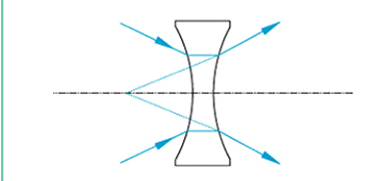Double concave lenses have a negative focal length and are typically used to increase the divergence of aggregated light.

Main characteristics
- Negative focal length:The focal length of a biconcave lens is negative, which means it does not focus light into a single point, but rather causes the incident light to diverge.
- Diverging light:When parallel rays pass through a biconcave lens, they diverge outward as if they were emanating from a virtual focal point behind the lens.
- virtual focus:The focal point generated by a biconcave lens is located on one side of the lens, which is a virtual focal point because the light rays do not actually intersect there.
application area
The divergent characteristics of biconcave lenses make them widely used in multiple fields:
- Correcting visual issues:In the field of glasses, biconcave lenses are used to correct farsightedness and help the eyes better focus on nearby objects.
- LASER SYSTEM:In some laser systems, double concave lenses are used to expand the beam to match the requirements of other optical components.
- optical instrument:In optical instruments such as microscopes and telescopes, biconcave lenses can be used as correction mirrors to improve imaging quality.
- Arts and entertainment:Double concave lenses are sometimes used to create special lighting effects in lighting design and stage effects.
A biconcave lens is a common optical element that has inward concave surfaces on both sides. The shape of this lens is similar to two bowls placed back-to-back, so it is called a double concave or negative lens in optics. Due to its unique geometric shape, the biconcave lens has the ability to disperse light rays, that is, it can cause the incident light rays to diverge or expand.
advantage
- Simplify the optical system:Double concave lenses can be combined with other types of lenses to correct the shape or focusing characteristics of light beams, simplifying the design of optical systems.
- Adjust the beam size:By diffusing the beam, the double concave lens can adjust the diameter of the beam, making it suitable for applications that require specific beam sizes.
- Cost effectiveness:Double concave lenses are usually easy to manufacture, so they have lower costs in mass production.
note
When using a biconcave lens, the following points need to be considered:
- Material selection:Select appropriate lens materials based on the spectral range of the application to ensure good light transmission performance.
- Lens quality:The quality of a lens, including its surface flatness and cleanliness, directly affects its optical performance.
- Combination use:In complex optical systems, biconcave lenses are often used in combination with other types of lenses to achieve specific optical effects.
conclusion
Double concave lens is an important optical component that plays a crucial role in multiple fields, especially in applications that require diverging light or adjusting beam shape.
| Double concave lens can process conventional indicators | |
| material | Optical glass, calcium fluoride, magnesium fluoride, silicon, germanium, zinc selenide, etc |
| Product Category | biconcave lens |
| Processing diameter (mm) | 1-600 |
| Diameter tolerance (mm) | ±0.03 |
| Thickness tolerance (mm) | ±0.03 |
| Surface smoothness (American standard) | 60-40或10-5 |
| Surface Accuracy | λ/10@632.8nm或者更高 |
| 焦距误差 | ±2% |
| 通光孔径 | >90% |
| 偏芯 | <3′或更高 |
| 倒角 | 0.2mmX45° |
| 镀膜 | 按需求定制 |







![62569b4e739531[1] 62569b4e739531[1]](https://asphericoptics.com/wp-content/uploads/2024/09/62569b4e7395311-800x701.jpg)